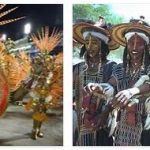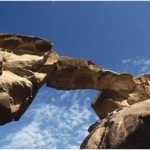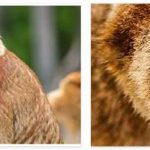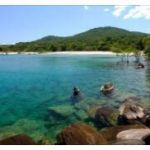| Official language | Portuguese |
| Capital | Bissau |
| Form of government | democratic presidential republic |
| Area | 36.125 km² |
| Residents | 1,420,000 |
| Currency | CFA Franc |
| Time zone | UTC |
| License plate | GUB |
| Internet TLD | .gw |
| Telephone area code | 00245 (Source: ALLCITYCODES) |
Geography
The Republic of Guinea-Bissau is located in West Africa on the Atlantic coast and, with a size of 36 125 km², is about the size of the Netherlands. The country borders Senegal in the north, Guinea in the east and south and the Atlantic in the west.The state territory includes the 60 islands off the coast of the Bissago archipelago. See Guinea-Bissau country abbreviation.
The coast is strongly divided by the mouth funnels of numerous rivers that reach deep inland. In this area there are extensive mudflats and marsh landscapes. The slightly hilly coastal plain is around 30 to 50 m above sea level, towards the east the country gradually rises to a plateau landscape that rises in the foothills of the Fouta-Djalon Mountains to a maximum of 300 m in the southeast of the country.
The capital, Bissau, is on the Atlantic coast.
Climate
Guinea-Bissau is located in the marginal tropics, the climate shows only little seasonal temperature fluctuations. The temperatures are between 25 °C and 28 °C all year round. During the rainy season, which lasts from May to October / November, a large part of the precipitation falls. In southern Guinea-Bissau fall up to 3,000 mm, in the north it is around 1,200 mm a year. Since the funnel mouths of the rivers reach far inland, floods often occur in the coastal country during the rainy season.
Flora and fauna
Mangroves and swamp forests predominate on the coast, oil palms are common. Evergreen rainforests grow on the coastal plain and on the offshore islands (in total, around 38% of the country is forested). In the east of Guinea-Bissau there is a moist savannah with light trees and bushes.
Crocodiles, hippos and numerous water birds such as pelicans, herons and flamingos live on the watercourses and in the marshes in the coastal area. Pangolin, vervet monkeys, semi-monkeys and gorse cats and numerous snake species can be found in the rainforests. The population of animals in the wet savannah in the east of the country is severely decimated. Antelopes, elephants, buffalos and leopards are found only sporadically.
Population
A total of around 1.42 million people live in Guinea-Bissau, almost a quarter of them in cities. By far the largest city is the capital Bissau with around 355,000 residents in the metropolitan area, other cities are for example Bafat¨¢ (18,000 residents) and Gab¨² (9,500). According to COUNTRYAAH, the population density is around 39 residents per square kilometer.
Several culturally different ethnic groups live in the country, a total of approx. 25. The largest population group are the Balante with approx. 30%, second largest group are the Fulbe (approx. 21%), followed by the Malinke (14%), Mandyako (13%) and Pepel (pap¨¦is, 7%). More than half of the residents of Guinea-Bissau are followers of natural religions, approx. 45% are Muslims, the rest are Christians. The official language is Portuguese, a Creole language (a mixture of Portuguese and African languages) and other African languages are often used as a common language.
The insufficient supply of food to the population and the poor health system are reflected in the life expectancy of only 47 years and the high infant mortality rate (over 10%). Since the birth rate averages five children per woman, the population growth is still a relatively high 3%. Almost 4% of the population are infected with HIV / AIDS.
School attendance is compulsory for children between the ages of seven and 13, but literacy is only 42.4%. About 70% of the population live below the poverty line.

Political system
According to the 1999 constitution, Guinea-Bissau is a democratic presidential republic. The head of state is the President (Jos¨¦ M¨¢rio Vaz (since June 2014), who is elected by the people for a term of five years (one-time re-election). He appoints the Prime Minister (Domingos Simões Pereira, since July 2014) in consultation with the party leaders of the Parliament represented parties.
The legislature lies with the National Assembly, whose 100 deputies are elected by the people for five years.
Guinea-Bissau is divided into eight regions and a capital district, the regions in turn in 37 sectors.
Economy
Guinea-Bissau is one of the ten poorest countries in the world and is highly dependent on foreign financial and development aid. Per capita income is estimated at $ 500. Due to the lack of state structures and the widespread poverty that favors corruption, the country is increasingly developing into a drug handling center (especially cocaine) between South America and Europe as well as the USA and Canada.
The most important area is agriculture, where two thirds are employed and generate about 60% of GDP. Rice, cassava, maize and sugar cane are mainly grown for our own needs. Cashew nuts, peanuts and palm kernels are exported. Food must be imported. Fine wood is exported to a small extent, but the forest stands are mainly used for the extraction of firewood. Fishing is important both for the provision of food to the population and for export.
The natural resources in Guinea-Bissau (including larger deposits of bauxite, zinc, copper, diamonds and petroleum) were mined primarily by foreign companies. Offshore oil deposits have been discovered off the coast. They have not yet been exploited, but could strengthen Guinea-Bissau’s economy in the future.
The most important trading partners for exports (cashew nuts, fish, shrimp, peanuts, palm kernels and wood) are India, Thailand and the USA. Senegal is the most important partner in the import of goods (especially food, machinery, vehicles, fuels), followed by Portugal, India and China.
The road network covers around 4,400 km, of which around 450 km are paved. The numerous rivers are important connections. There is an international airport near Bissau.
The currency is the CFA franc.







